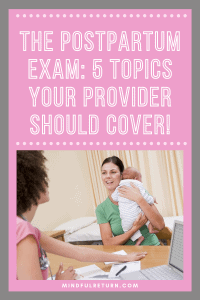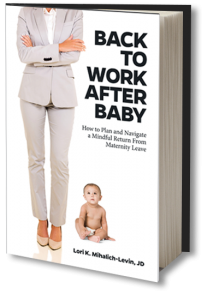 With the joy and terror of giving birth comes the inevitable worry about the well-being of our little ones. But too often – particularly in the US – the physical and emotional health of the mother or postpartum care is an afterthought. How much time have you spent thinking about your own health and well-being since you gave birth? Whether it was last week or a decade ago, I’d bet it’s probably not enough.
With the joy and terror of giving birth comes the inevitable worry about the well-being of our little ones. But too often – particularly in the US – the physical and emotional health of the mother or postpartum care is an afterthought. How much time have you spent thinking about your own health and well-being since you gave birth? Whether it was last week or a decade ago, I’d bet it’s probably not enough.
Here to fill us in on what you actually should be thinking about postpartum (from recovery, to sexuality, to mood), is Liz Nutter. Liz is an active-duty Army Certified Nurse-Midwife, a fellow in the American College of Nurse Midwives, and the founder of Military Women’s Wellness. (Sign up for her Always on Duty Masterclass Series, too. I’m honored to be one of her guest speakers in the Masterclass, talking about heading back to work after baby.)
Thank you for being our guest on the Mindful Return blog this week, Liz. And for encouraging us as mamas to advocate for ourselves.
**************************************************************
You received months of prenatal care. You spent hours talking with your obstetrical provider about your pregnancy and pending birth. And you were cared for during labor and birth and received care immediately post-delivery. But then the care stops…that is until your postpartum exam. In the United States, the “postpartum visit” usually signifies the end of your formal support and relationship with your obstetrical provider.
Optimal postpartum care provides an opportunity to promote your overall health and well-being during the vulnerable time that we are truly transitioning into motherhood. The American College of Obstetricians and Gynecologists (ACOG) recommends an initial postpartum assessment should be done within the first 3 weeks postpartum, either in person or by phone, to address any acute postpartum issues. Then, a comprehensive well-woman visit should be completed no later than 12 weeks postpartum. These postpartum visits provide information about postpartum depression, birth spacing, healthy eating, postpartum exercise, sexual health, and much more.
Research shows that 40% of women do not attend their postpartum visits. And maybe even more concerning, is the data from a national survey that demonstrates that less than one half of women who attend their postpartum visit received enough information at their visit to feel prepared to be released from obstetrical care (ACOG, 2018).
The remainder of this blog highlights what to expect in your postpartum exam, so you can advocate for yourself and your needs. A postpartum comprehensive visit should include a full assessment of your physical, social, and psychological well-being.
Topics to Cover in the Postpartum Exam
Physical Recovery: You should be assessed for the presence of pain, especially perineal or cesarean incisional pain, urinary incontinence, fecal incontinence, separation of your abdominal muscles (diastasis recti), resumption of physical activity, and weight loss assessment. Research demonstrates that 23.7% of women experience urinary incontinence immediately after childbirth, with only 2.7% of women still experiencing urinary incontinence 6 months postpartum (Hvidman et al., 2003). If you’re experiencing leaking or dribbling of urine, or fecal incontinence (which is much less common) tell your provider at your postpartum exam. This is not normal, and there is treatment available to help. Urinary incontinence can be helped in most cases with physical therapy of the pelvic floor muscles. Fecal incontinence usually requires surgical intervention.
Your obstetrical provider should assess your abdomen for diastasis recti (partial or complete separation of the rectus abdominis muscles). Diastasis recti is very common, with 60% of women experiencing it during either pregnancy or postpartum. It can result in lower back pain for up to 12 months postpartum if not treated (Sperstad, 2016). If you are still experiencing separation 8 weeks postpartum, you should perform pelvic floor and deep stomach muscle exercise specialized for diastasis recti with a physical therapist or postpartum fitness specialist.
Your provider should assess your weight loss and discuss resumption of physical activity. Most women lose weight steadily during the first 6 months postpartum, with the greatest weight loss being experienced in the first three months postpartum. You should lose no more than 4.5 pounds per month.
If you had an uncomplicated vaginal delivery, it is generally considered safe as soon as you feel ready to start exercising. The recommendation is for at least 150 minutes a week of moderate intensity aerobic activity spread out thought the week. If you had a cesarean section, an extensive vaginal repair, or a complicated pregnancy, you need to talk with your obstetrical provider about the best way to resume physical activity. Physical activity is not thought to affect breastmilk production.
Mood and Emotional Well-being: You will be screened for postpartum depression, anxiety, and sleep/fatigue. Be honest in your response to the questions you are asked, as they are designed to address your mental transition to motherhood. There is nothing to be ashamed about if you are not happy or are struggling. 1 out of 9 women develop postpartum depression. Postpartum depression may occur due to the changes in hormone levels after delivery, genetics, or stress. Obstetrical providers are able to develop treatment plans for women experiencing postpartum depression, including counseling and possible medication treatment.
Postpartum sleep and fatigue are two of the most common issues new moms struggle with daily in the months following birth. Research shows the average postpartum women sleeps an average of 7 hours each night. However, the sleep quality is low, due to caring for the infant at night (Doering & Dogan, 2018).
Postpartum fatigue includes both emotional and physical concerns, and remains high for several months postpartum. The health effects of poor sleep and postpartum fatigue include depression, early breastfeeding weaning and are often frequently overlooked by healthcare providers. If you are struggling with fatigue or sleep, talk with your obstetrical provider so they can develop a plan to help you until your baby starts to change sleeping patterns to nighttime hours.
Sexuality: You should be asked about your sexual health. You should also be asked if you are experiencing any concerns in your sex life. It is common for women to have less interest in sex postpartum and to experience some mild pain with penetration and vaginal dryness. Women who are breastfeeding often experience vaginal dryness. Research shows that 43% of women reported vaginal dryness 6 months after giving birth. You can still have an enjoyable sex life despite postpartum vaginal dryness. Use a lubricant when you have sex, or consider applying a vaginal moisturizer every few days. Increase foreplay, and try different techniques and positions.
Your provider should also discuss your desire for future pregnancies and recommendations for prevention of pregnancy for at least 6 months. If desired, you should also discuss a reproductive plan and selection of a contraceptive method that reflects your needs and preferences. Resumption of ovulation is unpredictable and can occur even before the onset of a period in breastfeeding women. In a postpartum mother who is not breastfeeding, ovulation returns around 39 days postpartum. Therefore the initiation of contraception, if desired, should begin between 3 to 6 weeks postpartum. If you are breastfeeding, your provider should discuss the theoretical concerns regarding hormonal contraception with breastfeeding.
Well Woman Exam: Your postpartum exam should include the discussion of any pregnancy complications. It should also include discussion about any potential future long-term health consequences including future childbearing considerations.
Your vaccination history should be reviewed, and any indicated immunizations should be offered. Your medications should all be reviewed. A well-woman screening exam, to include a pap smear test and pelvic examination, should be administered if indicated.
In July 2020, the American Cancer Society released new cervical cancer screening recommendations: women ages 25 to 65 with a cervix should be screened with an HPV test alone (instead of a pap smear) every 5 years. If HPV testing alone is not available, women should get screened with an HPV/Pap co-test every 5 years or a Pap smear test every 3 years (Fontham et al., 2020). If you had gestational diabetes, you should have a 75-gram, 2-hour oral glucose tolerance test ordered postpartum.
Infant Care and Feeding: Your provider should assess your comfort and confidence in caring for your newborn, including a discussion of how you’re feeding your baby. If you’re breastfeeding, your provider should assess your confidence with breastfeeding and assess for any breastfeeding associated pain. Guidance on logistics of pumping and storing and preparing pumped breastmilk, as well as your legal right to milk expression, should also be discussed if you are returning to work or school.
Advocate for Your Postpartum Health, Mama!
As you can see, the postpartum exam should be very comprehensive. Don’t be afraid to speak up if your provider fails to address the key components of the postpartum exam outlined above. This is your opportunity to get your concerns addressed!
If there is a problem, your provider can place an appropriate referral to other specialists as indicated. And if you’re feeling well, this is an opportunity to receive some positive feedback. Take the kudos, mama. You deserve them!
 Liz Nutter is an active-duty Army Certified Nurse-Midwife and a fellow in the American College of Nurse Midwives. She is currently stationed at Joint Base Lewis McChord, Washington. She is the founder of Military Women’s Wellness, a community designed to address the unique health and wellness needs of female service members. Liz is passionate about providing evidence-based education to women to help them advocate for themselves. She is also a mother to a lively almost three-year-old son!
Liz Nutter is an active-duty Army Certified Nurse-Midwife and a fellow in the American College of Nurse Midwives. She is currently stationed at Joint Base Lewis McChord, Washington. She is the founder of Military Women’s Wellness, a community designed to address the unique health and wellness needs of female service members. Liz is passionate about providing evidence-based education to women to help them advocate for themselves. She is also a mother to a lively almost three-year-old son!
References:
ACOG Committee Opinion No. 736: Optimizing Postpartum Care. Obstet Gynecol. 2018 May;131(5):e140-e150. doi: 10.1097/AOG.0000000000002633. PMID: 29683911.
Doering, J. & Dogan, S. (2018) A Postpartum Sleep and Fatigue Intervention Feasibility Pilot Study, Behavioral Sleep Medicine, 16:2, 185-201, DOI:10.1080/15402002.2016.1180523
Fontham, ETH, Wolf, AMD, Church, TR, Etzioni, R, Flowers, CR, Herzig, A, Guerra, CE, Oeffinger, KC, Shih, Y‐CT, Walter, LC, Kim, JJ, Andrews, KS, DeSantis, CE, Fedewa, SA, Manassaram‐Baptiste, D, Saslow, D, Wender, RC, Smith, RA. Cervical cancer screening for individuals at average risk: 2020 guideline update from the American Cancer Society. CA Cancer J Clin. 2020: 70: 321‐ 346. https://doi.org/10.3322/caac.21628
Hvidman L, Foldspang A, Mommsen S, Nielsen JB. Postpartum urinary incontinence. Acta Obstet Gynecol Scand. 2003 Jun;82(6):556-63. doi: 10.1034/j.1600-0412.2003.00132.x. PMID: 12780427.
Sperstad, J. B., Tennfjord, M. K., Hilde, G., Ellström-Engh, M., & Bø, K. (2016). Diastasis recti abdominis during pregnancy and 12 months after childbirth: prevalence, risk factors and report of lumbopelvic pain. British journal of sports medicine, 50(17), 1092–1096. https://doi.org/10.1136/bjsports-2016-096065
Want more practical tips on working parenthood? Check out my book, Back to Work After Baby: How to Plan and Navigate a Mindful Return from Maternity Leave



